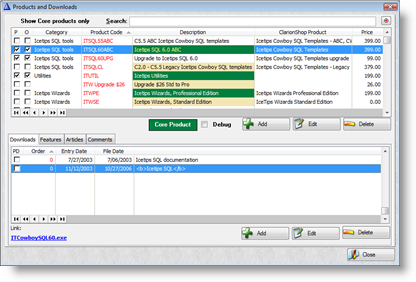
 Easy transition from a "Internal Converter" to "External Converter" and back. "External Converter" when several applications uses one data dictionary, and converter is common for all applications of a project. "Internal Converter" when converter is inside of application. Convert several versions of a file in one pass. Embed Points to tune up the data conversion code. Automatic data files conversion from old version to the latest one. Automatic registration of data dictionary changes. Thus during program update, programmer don't have to worry about data files conversion on Client computer, data conversion will be performed automatically and "transparently" for the end-user. Also, programmer can manually change the conversion code for each file and each version. So, when updated program starts with old data files, all old files will automatically be converted to the latest data files format. In other words when you change data file structure in the data dictionary, template will prepare data converter for every changed file automatically. Say Good-bye to error 47, and feel free to change your dictionary as you wish - integrated converter will automatically convert files when program starts.ĭC template tracks data dictionary changes and generates data conversion code.
Easy transition from a "Internal Converter" to "External Converter" and back. "External Converter" when several applications uses one data dictionary, and converter is common for all applications of a project. "Internal Converter" when converter is inside of application. Convert several versions of a file in one pass. Embed Points to tune up the data conversion code. Automatic data files conversion from old version to the latest one. Automatic registration of data dictionary changes. Thus during program update, programmer don't have to worry about data files conversion on Client computer, data conversion will be performed automatically and "transparently" for the end-user. Also, programmer can manually change the conversion code for each file and each version. So, when updated program starts with old data files, all old files will automatically be converted to the latest data files format. In other words when you change data file structure in the data dictionary, template will prepare data converter for every changed file automatically. Say Good-bye to error 47, and feel free to change your dictionary as you wish - integrated converter will automatically convert files when program starts.ĭC template tracks data dictionary changes and generates data conversion code. 
This will directly affect how our application will be generated in the final exercise.Data Conversion template is intended for automatic data files converting when application dictionary changes.

We will now look at "fine tuning" the dictionary in the Dictionary Editor. Now that everything is set up, click "OK" to create the relationship.Įxercise 4: Add a Lookup Table Clarion documentation often confuses tables and files, because with TopSpeed they are much the same. The generated source code will automatically maintain referential integrity between the tables. Choose "Restrict" from the "On Delete" dropdown list. In the Referential Integrity Constraints group box, choose "Cascade" from the "On Update" dropdown list. It is a good idea to give linked fields the same name where possible. Finally, click on "Map By Name" (because the field names are the same) so they relate correctly. Choose the "ORDER" table as the foreign table and "KEYCUSTOMER" as the foreign key. Use the Tab key to move to the next field. For the "CUSTOMER" table make sure the relationship type is 1:MANY and the primary key is "KEYCUSTOMER".







 0 kommentar(er)
0 kommentar(er)
